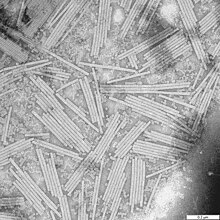microbiology

Escherichia coli , one of the most important model organisms in microbiology (secondary electron microscopy)

conidiophores with conidia from Trichoderma fertile . The fungus breaks down biotic polymers in soils.
( Phase contrast light microscopy )

Colpoda inflata , a representative of the soil protozoa that feeds on bacteria and influences the nutrient environment in soils

tobacco mosaic virus , the causative agent of mosaic disease in tobacco plants ( transmission electron microscopy , negative image)
Microbiology (composed of the ancient Greek μικρός mikrós "small", and biology ) is the science and teaching of microorganisms , i.e. living beings that cannot be recognized as individuals with the naked eye: archaea , bacteria , fungi , protozoa and and algae with few cells ( microalgae ), as well as viruses that are not living beings. Microbiology is a branch of biology and medicine .
Sub-areas
Microbiology is divided into special areas according to various aspects. The classification is based on the application in other disciplines (e.g. medical microbiology , food microbiology , technical microbiology), the habitat of the microorganisms ( geomicrobiology , marine microbiology, soil microbiology) or the microorganism groups treated:
- Bacteriology , the science and teaching of bacteria
- Mycology , the science and teaching of mushrooms
- Protozoology , the science and doctrine of ancient animals
- Virology , the science and study of viruses
The affiliation of viruses to living beings and thus to microorganisms is controversial in biology. Usually viruses are not counted among the living beings or they are considered to be the borderline form of life . This unclear status does not change the fact that microbiologists also research viruses. Therefore, virology is to be seen as a branch of microbiology.
Methods
In microbiology, methods of cytology (science and teaching of cells), genetics , biochemistry , ecology and systematics are used. Because of the small size of the microorganisms, microscopy and methods for their cultivation play an important role.
application
Microbiology and its results are among others in the biotechnology , including food technology , waste technology , material technology and medicine applied. In addition, microorganisms are ideally suited as model organisms in genetic research, as they have relatively small, manageable genomes and can easily be examined in very large numbers.
history
Microbiological research began with the use of microscopes to examine a wide variety of small living things and objects by Robert Hooke on behalf of the Royal Society and, above all, the first discovery of several microorganisms by the private scholar and cloth merchant Antoni van Leeuwenhoek (around 1665–1670). Both were among the first to design useful microscopes (invented between 1590 and 1610) as an essential prerequisite for the development of microbiology.
Other important facts provided the research of Louis Pasteur (1822-1895), of 1864, the foundations for the process of pasteurization created: by briefly heating food which is fermentation prevented and thus the durability of food increased. In addition, Pasteur refuted the theory of spontaneous generation , which had been valid until then , which had assumed the spontaneous formation of microorganisms from inanimate matter since ancient times.
Medical microbiology was significantly promoted by the work of the Berlin bacteriologist Robert Koch (1843–1910), who was the first to systematically search for microorganisms that cause diseases and who proved this connection with the discovery of the tuberculosis pathogen ( Mycobacterium tuberculosis ). Microbiology also owes him the introduction of solid nutrient media for the cultivation of microorganisms. Koch initially used potato slices for this, later he used gelatin to solidify liquid nutrient media, and finally he introduced agar as a means of solidifying nutrient media.
literature
- Moselio Schaechter, John Ingraham, Frederick C. Neidhardt: Microbe: The original with translation aids . Spectrum Akademischer Verlag, Heidelberg 2006, ISBN 3-8274-1798-8 .
- Heribert Cypionka : Fundamentals of Microbiology . 3. Edition. Springer-Verlag , Heidelberg a. a. O. 2006, ISBN 3-540-24084-5 . (Introductory textbook)
- Georg Fuchs (Ed.): General microbiology , founded by Hans-Günter Schlegel , 9th edition. Thieme, Stuttgart 2014, ISBN 978-3-13-444609-8 . (Introductory textbook)
- Michael T. Madigan, John M. Martinko, Paul V. Dunlap, David P. Clark: Brock - Biology of Microorganisms , 12th Edition. Pearson, San Francisco et al. O. 2009, ISBN 0-321-53615-0 . (Comprehensive textbook)
- Moselio Schaechter (Ed.): Encyclopedia of microbiology . 3. Edition. 6 volumes, Academic Press (Elsevier), Amsterdam et al. O. 2009, ISBN 978-0-12-373939-1 .
- Hans Günter Schlegel : History of Microbiology . 2nd edition, Wissenschaftliche Verlagsgesellschaft, Stuttgart 2004, ISBN 3-8047-2086-2 .
- Hans G. Schlegel : General microbiology. Thieme. Stuttgart 1969; 5th, revised and expanded edition, with the collaboration of Karin Schmidt, ibid 1981, ISBN 3-13-444605-7 ; 10th edition, ibid. 2017, ISBN 978-3-13-241885-1 .
- Herbert Hof, Rüdiger Dörries, Gernot Geginat, Robert Lee Müller: Microbiology . Thieme Verlag, Stuttgart 2000, ISBN 3-13-125311-8 . (Dual series: textbook / revision course)
- Gerhard Mittenhuber, Michael Hecker : Sheets on professional studies, biologist, microbiology . W. Bertelsmann Verlag, Gütersloh 1999, ISBN 3-7639-2761-1 .
- Eckhard Bast: Microbiological Methods . Spectrum Academic Publishing House Gustav Fischer, Heidelberg / Berlin 2001, ISBN 3-8274-1072-X .
- Herbert Weber (Ed.): Dictionary of microbiology . Gustav Fischer Verlag, Jena / Stuttgart / Lübeck / Ulm 1997, ISBN 3-437-35040-4 .
- Allen I. Laskin, Hubert A. Lechevalier (Editors): Handbook of Microbiology - Condensed Edition . CRC Press Inc., Cleveland, Ohio 1974, ISBN 0-87819-585-8 . (Reference work).
See also
Web links
- Short question! Why don't bacteria like jam? Questions and answers for pupils, interested laypeople and students
Individual evidence
- ↑ Werner Köhler : Microbiology . In: Werner E. Gerabek , Bernhard D. Haage, Gundolf Keil , Wolfgang Wegner (eds.): Enzyklopädie Medizingeschichte. De Gruyter, Berlin / New York 2005, ISBN 3-11-015714-4 , p. 988.